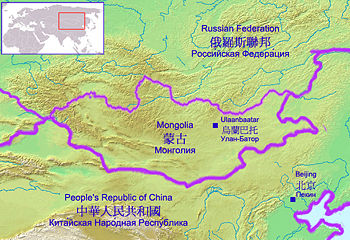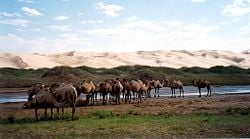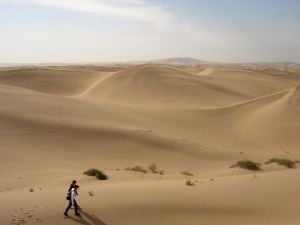Difference between revisions of "Gobi Desert" - New World Encyclopedia
(final edit and spell check) |
|||
| Line 5: | Line 5: | ||
[[Image:KhongorynElsCamels.jpg|thumb|250px|right|[[Bactrian camels]] by the [[dune|sand dunes]] of Khongoryn Els, [[Gobi Gurvansaikhan National Park|Gurvansaikhan NP]], [[Mongolia]].]] | [[Image:KhongorynElsCamels.jpg|thumb|250px|right|[[Bactrian camels]] by the [[dune|sand dunes]] of Khongoryn Els, [[Gobi Gurvansaikhan National Park|Gurvansaikhan NP]], [[Mongolia]].]] | ||
| − | The Gobi Desert, stretching into modern day China and Mongolia, expands its harsh rocky terrain over 500,000 square miles. Unlike the romanticized image of deserts with sweeping sand dunes, most of the landscape of the Gobi consists of rocky, hard packed terrain. While the solid land under foot made it easier to transverse the desert, | + | The Gobi Desert, stretching into modern day [[China]] and [[Mongolia]], expands its harsh rocky terrain over 500,000 square miles. Unlike the romanticized image of deserts with sweeping sand dunes, most of the landscape of the Gobi consists of rocky, hard packed terrain. While the solid land under foot made it easier to transverse the desert, catapulting the Gobi onto the scene of history as a viable trade route, there was very little settled human occupation in the area until modern times. A clue to the historical perception of the Gobi as an inhospitable region is found in its name, which derives from the Mongolian word for "very large and dry." The Gobi Desert is Asia's largest desert<ref name=nyt>{{cite book | first=John W. (ed.) | last=Wright | coauthors=Editors and reporters of ''The New York Times'' | year=2006 | title=The New York Times Almanac | edition=2007 | publisher=Penguin Books | location=New York, New York | id=ISBN 0-14-303820-6 | pages=456}}</ref>. |
| − | The modern Gobi Desert is roughly | + | The modern Gobi Desert is roughly crescent-shaped, lying between the [[Altai]] and [[Hangayn]] mountain ranges in the north and the [[Pei Mountains]] in the south. The eastern side of the desert is fringed by the [[Sinkiang region]], a large basin that extends towards the [[Plateau of Tibet]]. Towards the west of the Gobi lies the [[Greater Khingan Range]]. The large area of the Gobi Desert is often broken into two smaller sections, or ecoregions, in order to aid study of the region. |
| Line 13: | Line 13: | ||
===Ecoregions of the Gobi=== | ===Ecoregions of the Gobi=== | ||
| − | The Gobi, is | + | The Gobi, is categorized by the [[World Wildlife Federation]] as consisting of two broadly defined ecoregions: The Gobi Steppe Desert and the Gobi Lakes Valley Desert Steppe region. |
| − | The Eastern Gobu Desert Steppe lies in the eastern portion of the Gobi Desert, reaching from the Inner Mongolia Palteau(found in China) into Mongolia. Overall, this region covers an area of approximately 108,800 square miles before its borders fade into the lush grasslands of | + | The Eastern Gobu Desert Steppe lies in the eastern portion of the Gobi Desert, reaching from the [[Inner Mongolia Palteau]] (found in China) into Mongolia. Overall, this region covers an area of approximately 108,800 square miles before its borders fade into the lush grasslands of Mongolia and [[Manchuria]]. Salt marshes and small ponds are commonly found in the lower elevations in this area, but disappear when the elevation rises to form the [[Yin Shan Mountain Range]]. The Eastern Gobi Desert Steppe is categorized by drought adapted plant life and occasional thin wild grass patches.The Gobi Desert also harbors a few plant species that have been useful for both animals and humans alike , including: [[wormwood]], [[wild garlic]], [[saltwort]], and [[wild onion]]. |
| − | While the harsh environment and lack of | + | While the harsh environment and lack of visible vegetation may make the Gobi Desert appear inhospitable and unoccupied, the reverse appears to be true upon closer examination. The desert teems with life, boasting particularly large populations of [[Asian wild ass]] , [[Saiga antelope]] , [[black-tailed gazelle]] , and [[marbled poleca]]t. Smaller animals and insects also contribute to the desert ecosystem, along with sizable bird populations. |
[[Image:Desert - Inner Mongolia edit.jpg|thumb|right|The Gobi desert in Inner Mongolia, China.]] | [[Image:Desert - Inner Mongolia edit.jpg|thumb|right|The Gobi desert in Inner Mongolia, China.]] | ||
| − | The other ecosystem recognized by the World Wildlife Federation in the Gobi Desert is the Gobi Lakes Valley Desert Steppe, situated between the Khangai range and the Gobi-Altai and Mongol-Altai ranges in southwestern | + | The other ecosystem recognized by the World Wildlife Federation in the Gobi Desert is the Gobi Lakes Valley Desert Steppe, situated between the [[Khangai range]] and the [[Gobi-Altai]] and [[Mongol-Altai]] ranges in southwestern Mongolia. The Gobi Lakes Valley Desert Steppe is actually quite small for a complete ecosystem, measuring only 500 km long and 150 km wide. Despite its size, however, the region offers a broad range of landscape diversity, ranging from sand dunes to salt marshes. The most distinct feature of the area, however, and the one that earned the region its name, is the large number of lakes that dot the landscape. These lakes, mainly the [[Orog]], [[Boontsagaan]], [[Taatsyn tsagaan]], and the [[Ulaan nuur]] provide an unusual geographic feature for an area technically classified as a desert. |
| − | Like the East Gobi Desert Steppe, all the plant life found in the Gobi Lakes Valley Desert | + | Like the East Gobi Desert Steppe, all the plant life found in the Gobi Lakes Valley Desert Steppe region has adapted to the harsh conditions of life in the desert. In addition to the plants found in the East Gobi, the lakes of this region support a thriving aquatic community complete with marine animals and water dwelling plant forms. Lakes and marshes also provide a valuable habitat for bird communities. |
| − | In regards to the mammalian occupants of the Gobi Lakes Valley, most of the species are able to survive in the difficult terrain by using the terrain to their best advantage. Common species found in the Gobi include: Midday gerbil, dwarf hamster, long-eared hedgehog, and the Tibetan hare. Smaller animals like these are able to hide in the shade during the heat of the day and avoid direct exposure to the glaring midday sun. Some larger animals, however, also choose to make the Gobi Lakes Valley Desert Steppe their home, including :black-tailed Gazelle, Mongolian gazelle, and wild mountain sheep in the more | + | In regards to the mammalian occupants of the Gobi Lakes Valley, most of the species are able to survive in the difficult terrain by using the terrain to their best advantage. Common species found in the Gobi include: [[Midday gerbil]], [[dwarf hamster]], [[long-eared hedgehog]], and the [[Tibetan hare]]. Smaller animals like these are able to hide in the shade during the heat of the day and avoid direct exposure to the glaring midday sun. Some larger animals, however, also choose to make the Gobi Lakes Valley Desert Steppe their home, including : [[black-tailed Gazelle]], [[Mongolian gazelle]], and [[wild mountain sheep]] in the more mountainous regions. |
===Sands of the Gobi Deserts=== | ===Sands of the Gobi Deserts=== | ||
| − | + | Despite the fact that much of the Gobi desert consists of gravel or rocky terrain, the few sand dunes that due exist continue to draw scientific inquiry and tourists alike. There are two major theories about the origins of the sand dunes in Mongolia. One theory, which is the more popular theory among scientists, states that the sands where flown into the desert on wind currents, much the way that water can carry sand. This theory has gained popularity as science as been able to track wind currents in the region, and the sand dunes have been proven to have developed along traditional wind paths. While this is the more predominant theory, an alternative idea exists that claims the sand dunes were originally a product of water erosion. | |
===Climate=== | ===Climate=== | ||
| − | The Gobi Desert is noted for its extreme | + | The Gobi Desert is noted for its extreme temperature variation, with days commonly dipping from sweltering midday heat to freezing temperatures at night. During the winter, the Gobi Desert experiences extremely low temperatures that are not found in other surrounding areas of China and Mongolia. The reason for the the cooler temperatures, like the formation of the sand dunes, is theorized to be the result of the strong winds that sweep across the plains of the Gobi Desert. Unstopped by any significant mountain formations, the winds add a chill to the temperature that makes life in the winter Gobi Desert particularly difficult. |
| − | The summer season, while marked by | + | The summer season, while marked by temperatures rising towards 100°, is the rainy season for the Gobi Desert. The high temperatures bring with them the promise of rain, which is much needed for the inhabitants of the desert. While a welcome respite from the heat, the rains never seem to last long enough, annually only dropping about 100 to 150 mm on the plains. |
===Conservation Efforts=== | ===Conservation Efforts=== | ||
| − | The grasslands of the Gobi Desert are under extreme threat and may one day completely disappear if current practices in the region continue. The main culprit for the | + | The grasslands of the Gobi Desert are under extreme threat and may one day completely disappear if current practices in the region continue. The main culprit for the degradation of the grasslands is [[overgrazing]] by goats in the region, whose sheering fetch a high price in the form of [[cashmere]]. The problem of overgrazing has become compounded in recent years, as more and more people return to a agricultural lifestyle after the destruction of much of the urban economy of Mongolia. |
| − | The increase of agriculturalists in the area also threatens to detach much of the sand and topsoil in the desert. | + | The increase of agriculturalists in the area also threatens to detach much of the sand and topsoil in the desert. Under this threat, the loose sand or topsoil potentially could be swept away by the winds. This process is known as [[desertification]], and is common situation faced by deserts around the world. |
| − | On a scientific level, the Gobi Desert has also proven to be a valuable resource that needs to be conserved for future generations. The Gobi Desert harbors rich fossil remains, including dinosaur eggs and bones. Particularly the Gobi Desert has been used to study the phenomenon commonly | + | On a scientific level, the Gobi Desert has also proven to be a valuable resource that needs to be conserved for future generations. The Gobi Desert harbors rich [[fossil]] remains, including dinosaur eggs and bones. Particularly the Gobi Desert has been used to study the phenomenon commonly referred to as a "sand slides", where particle matter shifted on to living animals. This process, which resulted in death and physical preservation of the body, provides an important component for analyzing the extinction of dinosaurs. |
==History== | ==History== | ||
| − | + | The harsh environment of the Gobi Desert has proven prohibitive throughout history to permanent settled communities, and little of the advanced civilizations of China trickled into the desert. Those who did transverse the difficult terrain where commonly traders in its early history. Deserts often have to be crossed in order to reach potential markets, and the Gobi Desert was no exception. Trade routes dotted the gravel landscape, connecting the cities of Kalgan, Suzhou, Hami, and Beijing for economic purposes. Another significant route connected Kwei-hwa-cheng, Hami, annd Barku, while yet another ran between Lanzhou and Hami. | |
| − | + | Another significant portion of the population of the Gobi Desert was herdsmen and agriculturalists who crossed the desert in search of suitable grazing land for their livestock. While the population of herdsmen declined with the industrialization of Mongolia, recent economic strife and unemployment has caused the nomadic population of the Gobi to rise again. | |
| − | |||
| − | + | The Gobi Desert remained relatively unknown to Western Europe until [[Marco Polo]] brought back his personal accounts of travel in the 13th century. Many other explorers followed Marco POlo's example and voyaged through the Gobi Desert on the way to China. This trend led to an image of the Gobi Desert in Western Europe that shaped by personal accounts and perceptions,not necessarily fact. | |
| − | + | ||
| − | + | Global attention was once again focused on the region in the 1990s, when the area became a hotspot for paleontological research. | |
| − | |||
| − | |||
| − | |||
| − | |||
| − | |||
| − | |||
| − | |||
| − | |||
| − | |||
| − | |||
| − | |||
| − | |||
| − | |||
| − | |||
| − | |||
| − | |||
| − | |||
| − | |||
| − | |||
== See also == | == See also == | ||
| Line 88: | Line 68: | ||
</div> | </div> | ||
| − | == Further | + | == Sources and Further Reading == |
<div class="references-small"> | <div class="references-small"> | ||
* Cable, Mildred and French, Francesca. 1943. ''The Gobi Desert''. London. Landsborough Publications. | * Cable, Mildred and French, Francesca. 1943. ''The Gobi Desert''. London. Landsborough Publications. | ||
* Man, John. 1997. ''Gobi : Tracking the Desert''. Weidenfeld & Nicolson. Paperback by Phoenix, Orion Books. London. 1998. | * Man, John. 1997. ''Gobi : Tracking the Desert''. Weidenfeld & Nicolson. Paperback by Phoenix, Orion Books. London. 1998. | ||
| − | * Stewart, Stanley. 2001. ''In the Empire of Genghis Khan: A Journey among Nomads''. HarperCollins'' | + | * Stewart, Stanley. 2001. ''In the Empire of Genghis Khan: A Journey among Nomads''. HarperCollins Publishers, London. ISBN 0-00-653027-3. |
| + | *Lewis, Brenda Ralph. 2002. ''Great Civilizations''. Parragon Publishing, Bath. ISBN 0-75256-141-3 | ||
| + | *Costantino, Maria. 2001. ''The Illustrated Flag Handbook''. Gramercy Books, New York. ISBN 0-517-21810-0 | ||
| + | *[http://www.worldwildlife.org/wildworld/profiles/terrestrial/pa/pa1315_full.html#threats, World Wildlife Federation] Retrieved November 15, 2007. | ||
</div> | </div> | ||
Revision as of 01:49, 15 November 2007
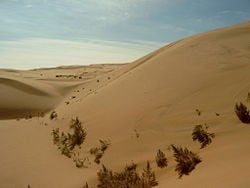
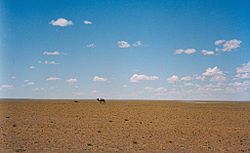
The Gobi Desert, stretching into modern day China and Mongolia, expands its harsh rocky terrain over 500,000 square miles. Unlike the romanticized image of deserts with sweeping sand dunes, most of the landscape of the Gobi consists of rocky, hard packed terrain. While the solid land under foot made it easier to transverse the desert, catapulting the Gobi onto the scene of history as a viable trade route, there was very little settled human occupation in the area until modern times. A clue to the historical perception of the Gobi as an inhospitable region is found in its name, which derives from the Mongolian word for "very large and dry." The Gobi Desert is Asia's largest desert[1].
The modern Gobi Desert is roughly crescent-shaped, lying between the Altai and Hangayn mountain ranges in the north and the Pei Mountains in the south. The eastern side of the desert is fringed by the Sinkiang region, a large basin that extends towards the Plateau of Tibet. Towards the west of the Gobi lies the Greater Khingan Range. The large area of the Gobi Desert is often broken into two smaller sections, or ecoregions, in order to aid study of the region.
Geography
Ecoregions of the Gobi
The Gobi, is categorized by the World Wildlife Federation as consisting of two broadly defined ecoregions: The Gobi Steppe Desert and the Gobi Lakes Valley Desert Steppe region.
The Eastern Gobu Desert Steppe lies in the eastern portion of the Gobi Desert, reaching from the Inner Mongolia Palteau (found in China) into Mongolia. Overall, this region covers an area of approximately 108,800 square miles before its borders fade into the lush grasslands of Mongolia and Manchuria. Salt marshes and small ponds are commonly found in the lower elevations in this area, but disappear when the elevation rises to form the Yin Shan Mountain Range. The Eastern Gobi Desert Steppe is categorized by drought adapted plant life and occasional thin wild grass patches.The Gobi Desert also harbors a few plant species that have been useful for both animals and humans alike , including: wormwood, wild garlic, saltwort, and wild onion.
While the harsh environment and lack of visible vegetation may make the Gobi Desert appear inhospitable and unoccupied, the reverse appears to be true upon closer examination. The desert teems with life, boasting particularly large populations of Asian wild ass , Saiga antelope , black-tailed gazelle , and marbled polecat. Smaller animals and insects also contribute to the desert ecosystem, along with sizable bird populations.
The other ecosystem recognized by the World Wildlife Federation in the Gobi Desert is the Gobi Lakes Valley Desert Steppe, situated between the Khangai range and the Gobi-Altai and Mongol-Altai ranges in southwestern Mongolia. The Gobi Lakes Valley Desert Steppe is actually quite small for a complete ecosystem, measuring only 500 km long and 150 km wide. Despite its size, however, the region offers a broad range of landscape diversity, ranging from sand dunes to salt marshes. The most distinct feature of the area, however, and the one that earned the region its name, is the large number of lakes that dot the landscape. These lakes, mainly the Orog, Boontsagaan, Taatsyn tsagaan, and the Ulaan nuur provide an unusual geographic feature for an area technically classified as a desert.
Like the East Gobi Desert Steppe, all the plant life found in the Gobi Lakes Valley Desert Steppe region has adapted to the harsh conditions of life in the desert. In addition to the plants found in the East Gobi, the lakes of this region support a thriving aquatic community complete with marine animals and water dwelling plant forms. Lakes and marshes also provide a valuable habitat for bird communities.
In regards to the mammalian occupants of the Gobi Lakes Valley, most of the species are able to survive in the difficult terrain by using the terrain to their best advantage. Common species found in the Gobi include: Midday gerbil, dwarf hamster, long-eared hedgehog, and the Tibetan hare. Smaller animals like these are able to hide in the shade during the heat of the day and avoid direct exposure to the glaring midday sun. Some larger animals, however, also choose to make the Gobi Lakes Valley Desert Steppe their home, including : black-tailed Gazelle, Mongolian gazelle, and wild mountain sheep in the more mountainous regions.
Sands of the Gobi Deserts
Despite the fact that much of the Gobi desert consists of gravel or rocky terrain, the few sand dunes that due exist continue to draw scientific inquiry and tourists alike. There are two major theories about the origins of the sand dunes in Mongolia. One theory, which is the more popular theory among scientists, states that the sands where flown into the desert on wind currents, much the way that water can carry sand. This theory has gained popularity as science as been able to track wind currents in the region, and the sand dunes have been proven to have developed along traditional wind paths. While this is the more predominant theory, an alternative idea exists that claims the sand dunes were originally a product of water erosion.
Climate
The Gobi Desert is noted for its extreme temperature variation, with days commonly dipping from sweltering midday heat to freezing temperatures at night. During the winter, the Gobi Desert experiences extremely low temperatures that are not found in other surrounding areas of China and Mongolia. The reason for the the cooler temperatures, like the formation of the sand dunes, is theorized to be the result of the strong winds that sweep across the plains of the Gobi Desert. Unstopped by any significant mountain formations, the winds add a chill to the temperature that makes life in the winter Gobi Desert particularly difficult.
The summer season, while marked by temperatures rising towards 100°, is the rainy season for the Gobi Desert. The high temperatures bring with them the promise of rain, which is much needed for the inhabitants of the desert. While a welcome respite from the heat, the rains never seem to last long enough, annually only dropping about 100 to 150 mm on the plains.
Conservation Efforts
The grasslands of the Gobi Desert are under extreme threat and may one day completely disappear if current practices in the region continue. The main culprit for the degradation of the grasslands is overgrazing by goats in the region, whose sheering fetch a high price in the form of cashmere. The problem of overgrazing has become compounded in recent years, as more and more people return to a agricultural lifestyle after the destruction of much of the urban economy of Mongolia.
The increase of agriculturalists in the area also threatens to detach much of the sand and topsoil in the desert. Under this threat, the loose sand or topsoil potentially could be swept away by the winds. This process is known as desertification, and is common situation faced by deserts around the world.
On a scientific level, the Gobi Desert has also proven to be a valuable resource that needs to be conserved for future generations. The Gobi Desert harbors rich fossil remains, including dinosaur eggs and bones. Particularly the Gobi Desert has been used to study the phenomenon commonly referred to as a "sand slides", where particle matter shifted on to living animals. This process, which resulted in death and physical preservation of the body, provides an important component for analyzing the extinction of dinosaurs.
History
The harsh environment of the Gobi Desert has proven prohibitive throughout history to permanent settled communities, and little of the advanced civilizations of China trickled into the desert. Those who did transverse the difficult terrain where commonly traders in its early history. Deserts often have to be crossed in order to reach potential markets, and the Gobi Desert was no exception. Trade routes dotted the gravel landscape, connecting the cities of Kalgan, Suzhou, Hami, and Beijing for economic purposes. Another significant route connected Kwei-hwa-cheng, Hami, annd Barku, while yet another ran between Lanzhou and Hami.
Another significant portion of the population of the Gobi Desert was herdsmen and agriculturalists who crossed the desert in search of suitable grazing land for their livestock. While the population of herdsmen declined with the industrialization of Mongolia, recent economic strife and unemployment has caused the nomadic population of the Gobi to rise again.
The Gobi Desert remained relatively unknown to Western Europe until Marco Polo brought back his personal accounts of travel in the 13th century. Many other explorers followed Marco POlo's example and voyaged through the Gobi Desert on the way to China. This trend led to an image of the Gobi Desert in Western Europe that shaped by personal accounts and perceptions,not necessarily fact.
Global attention was once again focused on the region in the 1990s, when the area became a hotspot for paleontological research.
See also
- Geography of China
- Geography of Mongolia
- Battle of Ikh Bayan
- List of deserts by area
ReferencesISBN links support NWE through referral fees
- This article incorporates text from the Encyclopædia Britannica Eleventh Edition, a publication now in the public domain.
- ↑ Wright, John W. (ed.) and Editors and reporters of The New York Times (2006). The New York Times Almanac, 2007, New York, New York: Penguin Books, 456. ISBN 0-14-303820-6.
Sources and Further Reading
- Cable, Mildred and French, Francesca. 1943. The Gobi Desert. London. Landsborough Publications.
- Man, John. 1997. Gobi : Tracking the Desert. Weidenfeld & Nicolson. Paperback by Phoenix, Orion Books. London. 1998.
- Stewart, Stanley. 2001. In the Empire of Genghis Khan: A Journey among Nomads. HarperCollins Publishers, London. ISBN 0-00-653027-3.
- Lewis, Brenda Ralph. 2002. Great Civilizations. Parragon Publishing, Bath. ISBN 0-75256-141-3
- Costantino, Maria. 2001. The Illustrated Flag Handbook. Gramercy Books, New York. ISBN 0-517-21810-0
- World Wildlife Federation Retrieved November 15, 2007.
External links
- Map, from "China the Beautiful"
- Flickr: Photos tagged with gobi
- Gobi Desert in Google Earth Requires Google Earth
| Deserts |
|---|
| Ad-Dahna | Alvord | Arabian | Aral Karakum | Atacama | Baja California | Barsuki | Betpak-Dala | Chalbi | Chihuahuan | Dasht-e Kavir | Dasht-e Lut | Dasht-e Margoh | Dasht-e Naomid | Gibson | Gobi | Great Basin | Great Sandy Desert | Great Victoria Desert | Kalahari | Karakum | Kyzylkum | Little Sandy Desert | Mojave | Namib | Nefud | Negev | Nubian | Ordos | Owyhee | Qaidam | Registan | Rub' al Khali | Ryn-Peski | Sahara | Saryesik-Atyrau | Sechura | Simpson | Sonoran | Strzelecki | Syrian | Taklamakan | Tanami | Thar | Tihamah | Ustyurt |
Credits
New World Encyclopedia writers and editors rewrote and completed the Wikipedia article in accordance with New World Encyclopedia standards. This article abides by terms of the Creative Commons CC-by-sa 3.0 License (CC-by-sa), which may be used and disseminated with proper attribution. Credit is due under the terms of this license that can reference both the New World Encyclopedia contributors and the selfless volunteer contributors of the Wikimedia Foundation. To cite this article click here for a list of acceptable citing formats.The history of earlier contributions by wikipedians is accessible to researchers here:
The history of this article since it was imported to New World Encyclopedia:
Note: Some restrictions may apply to use of individual images which are separately licensed.
